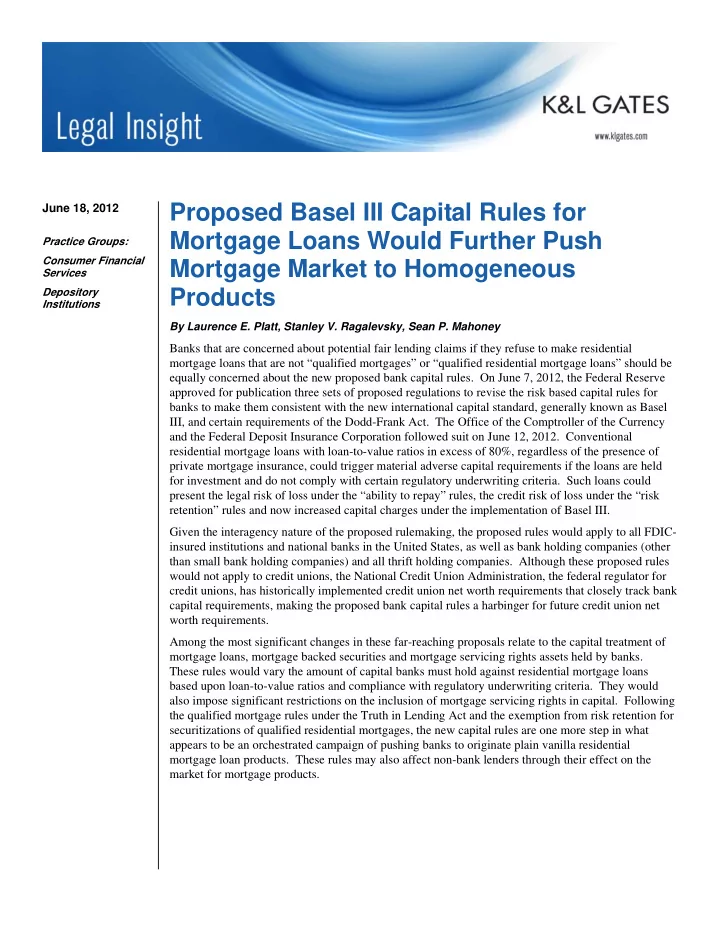

Proposed Basel III Capital Rules for June 18, 2012 Mortgage Loans Would Further Push Practice Groups: Consumer Financial Mortgage Market to Homogeneous Services Depository Products Institutions By Laurence E. Platt, Stanley V. Ragalevsky, Sean P. Mahoney Banks that are concerned about potential fair lending claims if they refuse to make residential mortgage loans that are not “qualified mortgages” or “qualified residential mortgage loans” should be equally concerned about the new proposed bank capital rules. On June 7, 2012, the Federal Reserve approved for publication three sets of proposed regulations to revise the risk based capital rules for banks to make them consistent with the new international capital standard, generally known as Basel III, and certain requirements of the Dodd-Frank Act. The Office of the Comptroller of the Currency and the Federal Deposit Insurance Corporation followed suit on June 12, 2012. Conventional residential mortgage loans with loan-to-value ratios in excess of 80%, regardless of the presence of private mortgage insurance, could trigger material adverse capital requirements if the loans are held for investment and do not comply with certain regulatory underwriting criteria. Such loans could present the legal risk of loss under the “ability to repay” rules, the credit risk of loss under the “risk retention” rules and now increased capital charges under the implementation of Basel III. Given the interagency nature of the proposed rulemaking, the proposed rules would apply to all FDIC- insured institutions and national banks in the United States, as well as bank holding companies (other than small bank holding companies) and all thrift holding companies. Although these proposed rules would not apply to credit unions, the National Credit Union Administration, the federal regulator for credit unions, has historically implemented credit union net worth requirements that closely track bank capital requirements, making the proposed bank capital rules a harbinger for future credit union net worth requirements. Among the most significant changes in these far-reaching proposals relate to the capital treatment of mortgage loans, mortgage backed securities and mortgage servicing rights assets held by banks. These rules would vary the amount of capital banks must hold against residential mortgage loans based upon loan-to-value ratios and compliance with regulatory underwriting criteria. They would also impose significant restrictions on the inclusion of mortgage servicing rights in capital. Following the qualified mortgage rules under the Truth in Lending Act and the exemption from risk retention for securitizations of qualified residential mortgages, the new capital rules are one more step in what appears to be an orchestrated campaign of pushing banks to originate plain vanilla residential mortgage loan products. These rules may also affect non-bank lenders through their effect on the market for mortgage products.
Proposed Basel III Capital Rules for Mortgage Loans Would Further Push Mortgage Market to Homogeneous Products Background on Capital Rules Regulatory capital requirements are designed to ensure that banks retain a sufficient cushion to absorb losses during times of economic stress. Capital is generally measured as a ratio of capital components (i.e., tier 1 capital, tier 2 capital, etc.) compared to risk-weighted assets. Low risk assets such as government securities generally require little or no capital cushion, but assets that present greater risk require a larger capital cushion. The risk weighting of assets is the mechanism by which regulators both determine the amount of capital required for specific types of assets and indirectly influence the type of activities in which banks elect to engage. Since the implementation of the Basel II Capital Accord in 2006, two sets of capital rules have effectively governed the U.S. banking industry: the standardized approach and the advanced approach. The standardized approach is used by most banks to calculate capital and capital is determined by assigning risk weighting for assets based upon regulatory criteria. Banks with more than $250 billion in assets, however, are permitted to use the advanced approach, which measures capital using regulatory formulas that incorporate inputs determined in accordance with a bank’s internal ratings-based system. Banks need to qualify to use the advanced approach and there is a process to ensure that the internal ratings systems are sufficiently robust. Banks that utilize the advanced approach will also be subject to the standardized approach insofar as the standardized approach will set the floor on the total amount of capital required at such banks. With regard to residential mortgage loans, the most significant changes proposed are to the standardized approach, which could affect the extent to which (or the pricing at which) banks are willing to hold loans in portfolio. Capital Treatment of Residential Mortgage Loans The changes affecting capital treatment of mortgage loans primarily impact banks that use the standardized approach – banks with less than $250 billion in assets. The proposed rules make no changes to the capital treatment of mortgage loans guaranteed by the U.S. government or an agency of the U.S. government. Loans that are unconditionally guaranteed would retain a risk weighting of zero, while loans that are conditionally guaranteed will retain a risk weighting of 20%. For loans that are not guaranteed by the U.S. government or a U.S. government agency, risk weightings will change from a uniform 50% to anywhere from 35% to 200%, with the lower risk weightings available only to mortgage loans that conform to narrow regulatory criteria. Risk weightings, and therefore capital requirements, increase with an increased loan-to-value ratio. Specific risk weightings are as follows: Category 1 Category 2 residential residential mortgage mortgage exposure Loan-to-value ratio (in percent) exposure (in percent) (in percent) Less than or equal to 60 35 100 Greater than 60 and less than or equal to 80 50 100 Greater than 80 and less than or equal to 90 75 150 Greater than 90 100 200 2
Recommend
More recommend